Closed Loop AIO Liquid Coolers: 14-way Mega Roundup Review
by E. Fylladitakis on February 12, 2014 7:00 AM ESTTesting Results, Maximum Fan Speed (12V)
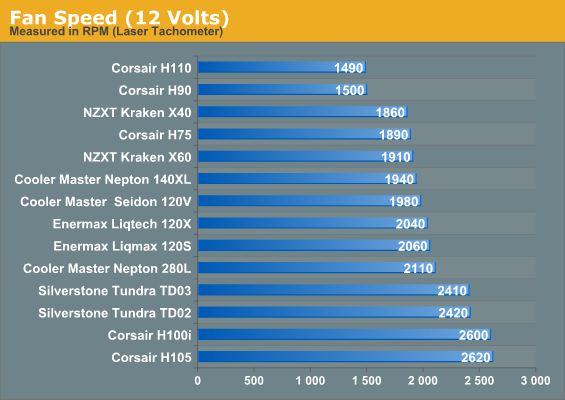
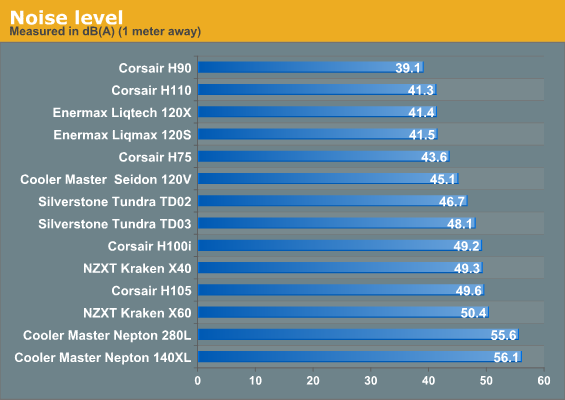
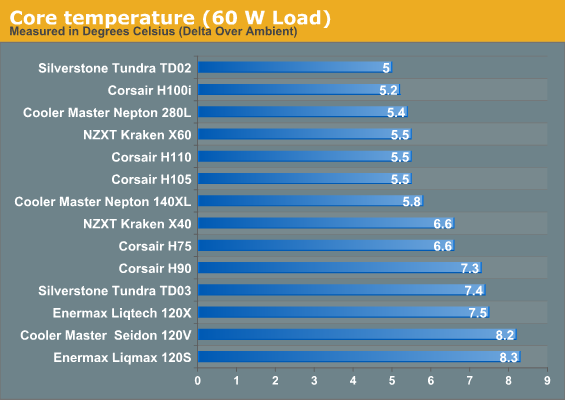
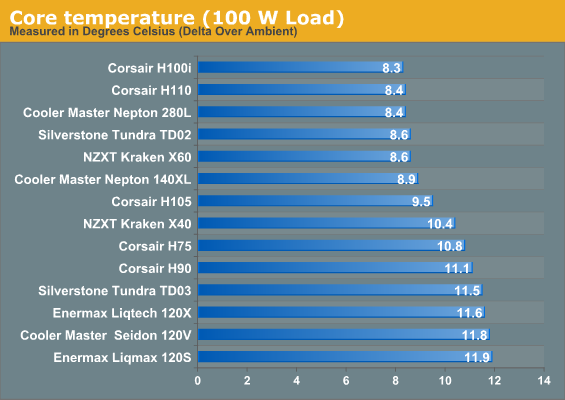
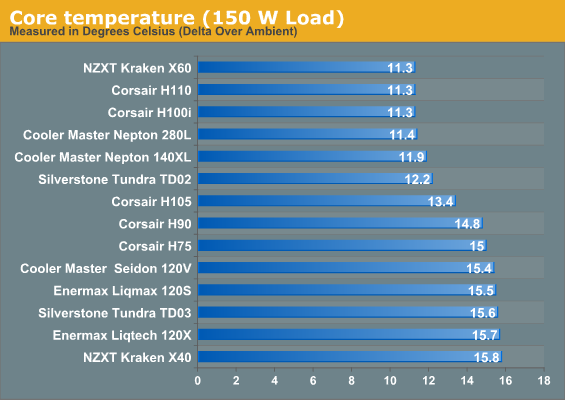
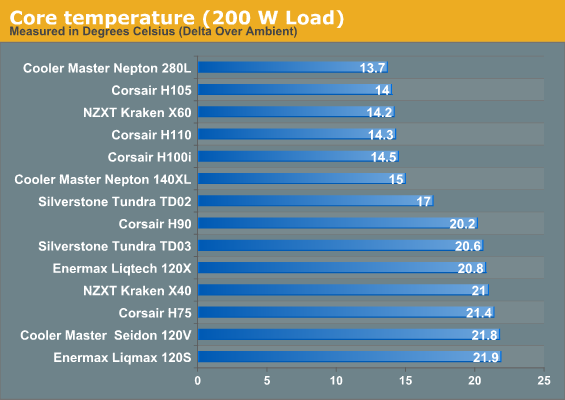

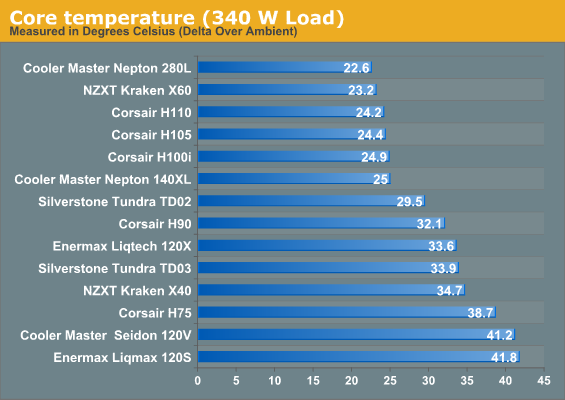

The above charts depict exactly why a user needs to be more than just a little careful when selecting a cooler. Even though they appear similar and some of them even nearly identical, the performance of each and every AIO cooler that we have tested varies greatly. For instance, Cooler Master obviously sought to provide the best heavy-load performance possible and they did manage to reach the top of our charts; however, the noise of the fans that Cooler Master supplied at maximum speed is intolerable for daily use by any standards.
To give you a rough estimate, 56 dB(A) represents about the same level of sound as a typical box fan the same distance. The Nepton 280L is closely followed by the NZXT Kraken X60 and then the Corsair H110, both of which share about the same size and design but not nearly the same noise levels. The NZXT Kraken X60 is over 5 dB(A) quieter than the Nepton 280L, a very perceptible difference, while the Corsair H110 generates only 41.3 dB(A), which is equivalent to a soft humming noise and fairly comfortable for daily use.
Naturally, the performance decreases as we move to AIO coolers with smaller radiators, with the Corsair H100i leading the coolers using 120mm fans but its stock fans run at 2600 RPM, generating high noise levels. The Enermax Liqtech 120X and Silverstone Tundra TD03 and their beefy radiators deliver great thermal performance when compared to other single-fan AIO coolers, although Enermax proved that they could offer roughly the same performance with just one fan and much lower noise levels, making Silverstone's choice to include two fans appear somewhat redundant.
Under a low thermal load however, the charts shift greatly. As the thermal load is much lower, the low temperature dissipation efficiency of the cooler now matters a lot more than its maximum thermal load capacity. Corsair's H100i offers the best thermal performance, outperforming coolers with significantly larger radiators, including Corsair's own H110, closely followed by another 240mm long cooler, the Silverstone Tundra TD02. The gap between the budget-level and high-performance products now closes, with the Corsair H75 being the most notable example, as it manages to outperform its own larger version, the H105. Apparently, bigger is not always better and the lower flow resistance of the single fan radiator gives the Corsair H75 a faster energy transfer rate at lower temperature deltas.










139 Comments
View All Comments
Dustin Sklavos - Wednesday, February 12, 2014 - link
Good lord.If I'd known my successor would produce results this thorough I'd've stepped aside a long time ago.
Really well done piece of work.
E.Fyll - Wednesday, February 12, 2014 - link
Thank you for the praise Dustin, yet I still stand unworthy of it. :)Dustin Sklavos - Wednesday, February 12, 2014 - link
I'm enjoying your work tremendously. Now that I'm at Corsair I'm glad we have someone we can send case/cooling/PSU hardware to that meets and beats the AnandTech standard.creed3020 - Wednesday, February 12, 2014 - link
Yeah Dustin....I have seriously enjoyed your labors here at AT and do miss them. Your successor has changed the paradigm so much that it's hard to compare, but it's a awesome reboot to this area of reviews here at AT.I, however, have to agree with many other commenters that a secondary dataset produced with the same 120mm/140mm fans does have it's merit as it will provide an objective evaluation of the radiator and pumps. This is one area where I am really curious to see quality differences in the products. I am fully aware that each OEM is very careful in their selection of a fan which matches their product. This is not done by lottery, that much is clear to me. The OEM behind the Silverstone/Enermax product intrigues me, as I am a fan of Silverstone products and use their cases exclusively for all of my desktops, gaming PCs, and HTPCs. The Tundra's seems like they are ripe for a revision!
BigLeagueJammer - Wednesday, February 12, 2014 - link
Under Noise Level Reference Values, your first one of <35dB(A) being "Virtually inaudible" doesn't match up with most sources I've seen. Most rate that as "very quiet" and say the limit of human hearing as 10 db(A). If other sources say things like a ticking watch is around 20 db(A) which in a quiet room is easy to hear, then 35 seems too high for your qualification of "virtually inaudible".E.Fyll - Wednesday, February 12, 2014 - link
True, I am afraid that the lot of "copy/paste-ing" online has produced a lot of bad information going around. Some are works of fiction, some are misinterpretations of confused people, some...I don't even want to know.So, copying my answer from above:
"Sub-35 dB(A) levels are generally impossible to notice by a human ear. Sub-30 dB(A) levels are next to impossible to record with anything less than science lab-grade equipment. There is no handheld or desktop dB(A) meter that can perform such readings. If you have seen reviews stating sub-30 dB(A) levels, make sure to check their methodology (given that there is any). Either the meter cannot read lower than 30 dB(A) (and/or will display a bogus reading, as most cheap Chinese meters do) and the review is a fictional text or their methodology is based on dB readings, not dB(A) readings, which is useless to a consumer."
I think it will suffice for me to say that you cannot possibly hear what an instrument designed for this specific purpose cannot even record. In theory, the human hearing threshold is 1 dB(A); in practice however, that is true only for specific frequencies. The background noise of a typical room is almost always above 32-33dB(A).
Jon-R - Wednesday, February 12, 2014 - link
What is your opinion on the tests done over at SilentPCReview? They test using lab-grade equipment. A rundown can be found here: http://www.silentpcreview.com/article875-page2.htm...They use reference fans which measure around 13dBA at their slowest fan speeds, and they don't think highly of AIO water-cooling at all, as none of the tested ones have come close to the best air-coolers when it comes to quiet cooling.
E.Fyll - Wednesday, February 12, 2014 - link
From what I can see, they are using a highly sensitive microphone and a computer's sound card to record the results, connected through an amplifier. Although the equipment is very good, this is not "lab grade equipment" but just a customized setup. A very good setup nonetheless, including an anechoic chamber. They have a microphone with a self-noise of 8 dB, which measures 11 dB(A) inside the aforementioned anechoic chamber.It will suffice to say that their results are just in no way comparable to mine. Actually, as noise level measurements are environment-specific, you should only compare the results of a same setup, never in-between different setups. Unless they are all science labs with multiple ISO certifications, of course. Given that my room floor noise level is over 30 dB(A) and they are using a sub-12 dB(A) anechoic chamber, I believe that I do not have to stress how different the results out of these two setups are.
As far as equipment goes, for example, this is a cheap lab grade sound analyzer and still costs 5 times more than the whole setup that you showed me, microphones and secondary equipment aside:
http://www.nti-audio.com/en/products/flexus-fx100....
Jon-R - Wednesday, February 12, 2014 - link
But you're not saying that their measurements are inaccurate, only that they've got a significantly lower noise-floor than what you're using? So it boils down to the difference between what is considered silent? Because 30dBA is louder than their reference fan it its loudest setting, and far beyond what they consider acceptable. Just as a reference, they measured 43 dBA for the Silverstonde TD03 at 12v, and 30 dBA at 7v.E.Fyll - Wednesday, February 12, 2014 - link
"Inaccurate" is a harsh word when it comes to sound pressure level measurements. Although I would not hesitate to use this word for most other types of tests, there are far too many variables at stake here. I believe that their setup may be better than mine. I am just using a good handheld sound level meter, with the product positioned in the middle of a standard room.I would simply stick with "different".
Sound levels are additive. If you have a noise source of 20 dB(A) and added another source of 20 dB(A), the room noise would not be 20 dB(A) but 23 dB(A). A third source would make it 24.8 dB(A) and so on. So, a fan that would measure 18 dB(A) inside an 12 dB(A) anechoic chamber, will still add to the 30.4 dB(A) floor noise of my room. The difference is the magnitude, as the scale is logarithmic. As you said, the TD03 added about 18 dB(A) and 30 dB(A) to their setup, when it adds 8.3 dB(A) and 17.7 dB(A) to mine, because of the higher background noise. These differences are in no way comparable to each other; that is only possible when the scale is linear. The further you move up the decibel scale, the largest the increase of SPL becomes per single decibel.